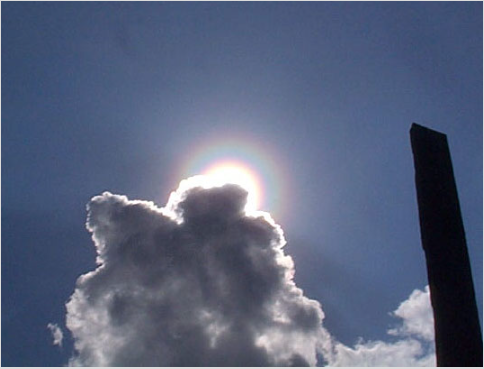Corona around the sun
The Corona around the Sun: A Spectacular Atmospheric Phenomenon
Have you ever noticed a bright halo-like ring surrounding the sun on a clear day? This awe-inspiring sight is known as the corona, a fascinating atmospheric optics phenomenon. While most people are familiar with solar eclipses and their associated corona, this article will focus on the corona that can be seen around the sun on any ordinary day.
Understanding the Corona
The corona is caused by the scattering of sunlight by tiny water droplets or ice crystals in the Earth's atmosphere. When sunlight encounters these particles, it gets scattered in all directions. However, the shorter wavelengths of light, such as blue and violet, are scattered more efficiently than longer wavelengths like red and orange. As a result, the corona appears as a circular band of colors surrounding the sun, with blue and violet hues on the inside and red and orange hues on the outside.
Atmospheric Conditions and the Corona
Various atmospheric conditions influence the visibility and intensity of the corona. Here are some factors that can affect the appearance of the corona:
-
Clouds: Cumulus clouds, like the one captured in the image above, can enhance the visibility of the corona. The water droplets present in these clouds efficiently scatter light, creating a striking silver lining effect around the sun.
-
Moisture Content: The presence of moisture in the atmosphere is crucial for the formation of the corona. Higher humidity levels increase the likelihood of water droplets or ice crystals being present, leading to a more pronounced corona.
-
Air Pollution: Pollution particles, such as dust or smoke, can also contribute to the formation of the corona. These particles act as nuclei for water droplets or ice crystals to condense around, enhancing the scattering of light and intensifying the corona's appearance.
Observing the Corona
To observe the corona around the sun, it is essential to take precautions to protect your eyes. Looking directly at the sun can cause permanent damage to your eyesight. Here are some safe methods for observing the corona:
-
Solar Filters: Specialized solar filters, such as solar viewing glasses or telescopes with solar filters, can block out harmful rays and allow you to safely view the corona.
-
Indirect Viewing: One of the safest ways to observe the corona is through indirect viewing methods. This can be done by projecting the image of the sun onto a white surface using a pinhole projector or by using binoculars or a telescope to project the image onto a screen.
The Science Behind the Corona
The formation of the corona is intricately tied to the physics of light scattering and the properties of water droplets or ice crystals in the atmosphere. Understanding these scientific principles can deepen our appreciation for this captivating phenomenon.
-
Rayleigh Scattering: The scattering of sunlight by small particles in the atmosphere follows Rayleigh scattering, where shorter wavelengths are scattered more strongly. This is why the inner part of the corona appears bluish, as blue light is scattered more efficiently than longer wavelengths.
-
Mie Scattering: When the size of the particles in the atmosphere becomes comparable to the wavelength of light, Mie scattering occurs. This type of scattering contributes to the reddish hues observed in the outer part of the corona.
-
Diffraction: The diffraction of light around the edges of water droplets or ice crystals also plays a role in shaping the appearance of the corona. This diffraction causes interference patterns, enhancing certain colors and creating intricate structures within the corona.
Cultural Significance of the Corona
Throughout history, various cultures have interpreted the corona as a symbol or omen. In some ancient civilizations, it was seen as a divine halo around celestial bodies, representing spiritual significance or celestial events. Today, the corona continues to captivate and inspire people, evoking a sense of wonder and reminding us of the beauty and complexity of our natural world.
In conclusion, the corona around the sun is a remarkable atmospheric optics phenomenon that occurs when sunlight interacts with water droplets or ice crystals in the Earth's atmosphere. Understanding the scientific principles behind its formation, observing it safely, and appreciating its cultural significance can enrich our experience of this breathtaking natural spectacle. So, next time you gaze at the sun on a clear day, take a moment to marvel at the magnificent corona encircling our nearest star.

Bright corona around the sun
Imaged by Michael Ellestad (atmospheric optics site) in August '03. The cumulus cloud is casting faint crepuscular rays and shadows. Water droplets in the thinner regions at the cloud edge are scattering light forwards very efficiently to produce a "silver lining". ©2003 Michael Ellestad, used with permission.
Note: this article has been automatically converted from the old site and may not appear as intended. You can find the original article here.
Reference Atmospheric Optics
If you use any of the definitions, information, or data presented on Atmospheric Optics, please copy the link or reference below to properly credit us as the reference source. Thank you!
-
<a href="https://atoptics.co.uk/blog/corona-around-the-sun/">Corona around the sun</a>
-
"Corona around the sun". Atmospheric Optics. Accessed on April 25, 2024. https://atoptics.co.uk/blog/corona-around-the-sun/.
-
"Corona around the sun". Atmospheric Optics, https://atoptics.co.uk/blog/corona-around-the-sun/. Accessed 25 April, 2024
-
Corona around the sun. Atmospheric Optics. Retrieved from https://atoptics.co.uk/blog/corona-around-the-sun/.